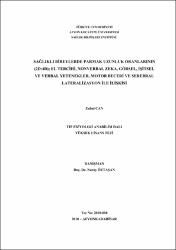| dc.contributor.advisor | Öztaşan, Nuray | |
| dc.contributor.author | Can, Zuhal | |
| dc.date.accessioned | 2015-03-05T07:05:05Z | |
| dc.date.available | 2015-03-05T07:05:05Z | |
| dc.date.issued | 2010 | |
| dc.date.submitted | 2010 | |
| dc.identifier.citation | Can, Zuhal. Sağlıklı Bireylerde Parmak Uzunluk Oranlarının (2d:4d); El Tercihi, Nonverbal Zeka, Görsel, İşitsel ve Verbal Yetenekler, Motor Beceri ve Serebral Lateralizasyon ile İlişkisi. Afyonkarahisar: Afyon Kocatepe Üniversitesi,2010. | en_US |
| dc.identifier.uri | http://hdl.handle.net/11630/2477 | |
| dc.description.abstract | Bu çalışmada, bayan ve erkeklerde el, ayak göz tercihleri, parmak uzunluk oranları (2D:4D), nonverbal zeka (IQ), el motor becerisi ve bu parametreler arası ilişkileri araştırmak amaçlanmıştır. Çalışmaya 18-25 yaş arası toplam 439 gönüllü katılımcı alındı. El tercihi ‘Edinburg El Tercihi Anketi’ ile, IQ puanı ‘Cattell’s Culture Free Intelligence Test’ ile ve motor beceri ‘Çivi Hareket Testi’ ile ölçüldü. Göz tercihi için anahtar deliğine bakma gözü, ayak tercihi için topa vurma ayağı ve ailede solak olup olmadığı sorgulandı. Her el için ayrı ayrı parmak uzunlukları anatomik sınırlardan dijital kumpasla ölçüldü ve (2D:4D) oranları hesaplandı. İstatistiksel değerlendirme, SPSS 16.0 bilgisayar programında t testi, ki kare testi ve Pearson korelasyon analiziyle yapıldı. Sağ ayak tercihinin bayanlarda erkeklerden fazla, sol ayak ve her iki ayak tercihlerinin de erkeklerde bayanlardan fazla olduğu bulundu. Bayan ve erkeklerde lateralizasyon katsayıları, sağ ve sol el (2D:4D) oranları, IQ puanları arasında istatistiksel olarak anlamlı bir fark bulunmazken motor beceri değeri bayanlarda erkeklerden yüksek bulundu. Cinsiyet farkı olmaksızın katılımcıların sağ ve sol el (2D:4D) parmak oranları arasında anlamlı korelasyon saptandı. Bayanlarda sağ el (2D:4D) oranı ile IQ puanı arasında anlamlı korelasyon bulundu. Erkeklerde ise sol el (2D:4D) oranı ile IQ puanı arasında anlamlı korelasyon saptandı. Erkeklerde lateralizasyon katsayısı ile motor beceri değeri arasında anlamlı korelasyon olduğu gösterildi. Sonuç olarak bayanlarda el motor becerisinin erkeklerden daha yüksek olduğu belirlendi. Yüksek IQ puanında (2D:4D) parmak oranının arttığı, aynı zamanda bu ilişkide cinsiyete göre farklı ellerin (2D:4D) oranının yer aldığı bulundu. Bu çalışma ile erkeklerde elde sağlaklık arttıkça el motor becerisinin arttığı sonucuna varıldı. | en_US |
| dc.description.abstract | In this study, the associations among the parameters of hand, foot and eye preferences, ratio of digit lengths (2D:4D), nonverbal intelligence (IQ), hand motor skill in man and women were aimed to investigate. A total of 439 volunteer participants aged 18 to 25 were included fort his study. The parameters were determined as folllows: Hand preference using ‘Edinburg Hand Preference questionnaire’, IQ point using ‘Cattell’s Culture Free Intelligence Test’ and motor skill using ‘Nail Movement Test’. For parameter of eye preference, the eye used for key hole were questioned, for foot preference the foot used for kicking the ball as well as the presence of someone in the family who kicks the ball by left foot. Respective finger length from anatomic boundaries was measured using digital compass caliper and the ratios of (2D:4D) were calculated. Statistical analyses were carried out by using t test, chi square test and Pearson correlation test of SPSS 16.0 computer program. Right foot preference was found to be higher in women than men, while left and all foot preference was found to be higher in men than women. While no statistically significant difference was found between the lateralization coefficients, right and left hand ratios (2D:4D), and IQ points in both men and
women; the value for motor skill was higher in women in comparison to men. A meaningful correlation was determined between right and left hand digit ratios (2D:4D) of participants without any gender preference. In women, a positive correlation was found between right hand ratio (2D:4D) and IQ point. On the other hand, in men, a positive correlation was found between left hand ratio (2D:4D) and IQ point. A positive correlation between lateralization coefficient and motor skill values was also been shown in men. In conclusion, hand motor skill was higher in women than the one in men. Digit ratios (2D:4D) were found higher in the ones having higher IQ points. This was particularly valid for different digit ratios (2D:4D) depending on the gender. Altogether, in light of this study it was concluded that the motor skills were higher in men who have more lateralization (towards right). | en_US |
| dc.language.iso | tur | en_US |
| dc.publisher | Afyon Kocatepe Üniversitesi, Sağlık Bilimleri Enstitüsü | en_US |
| dc.rights | info:eu-repo/semantics/openAccess | en_US |
| dc.subject | Parmak uzunluk oranı | en_US |
| dc.subject | Nonverbal zeka | en_US |
| dc.subject | Motor beceri | en_US |
| dc.subject | El | en_US |
| dc.subject | Ayak | en_US |
| dc.subject | Göz tercihi | en_US |
| dc.title | Sağlıklı Bireylerde Parmak Uzunluk Oranlarının (2d:4d); El Tercihi, Nonverbal Zeka, Görsel, İşitsel ve Verbal Yetenekler, Motor Beceri ve Serebral Lateralizasyon ile İlişkisi | en_US |
| dc.type | masterThesis | en_US |
| dc.department | Afyon Kocatepe Üniversitesi, Sağlık Bilimleri Enstitüsü, Temel Tıp Bilimleri Bölümü | en_US |
| dc.relation.publicationcategory | Tez | en_US |



















